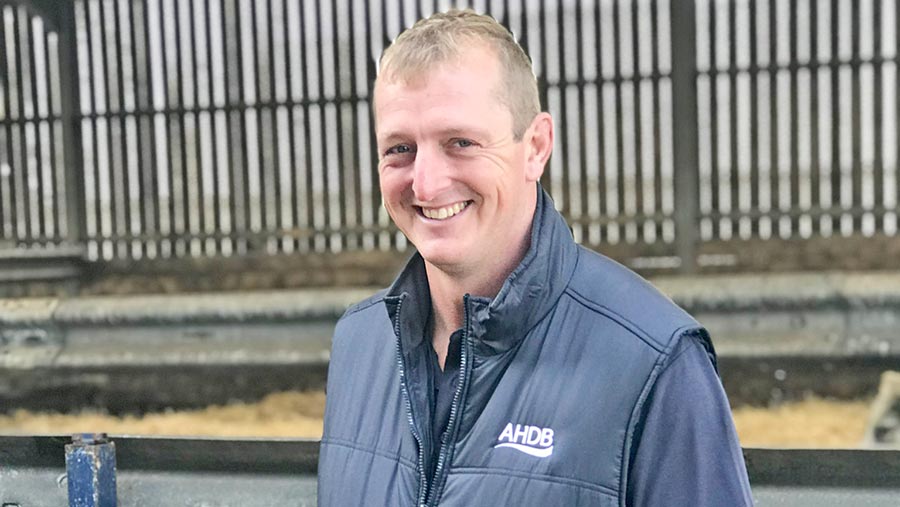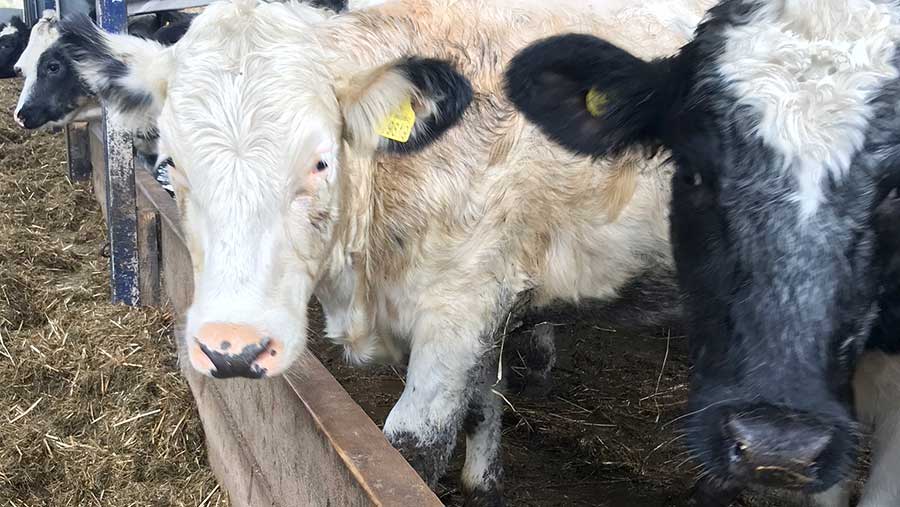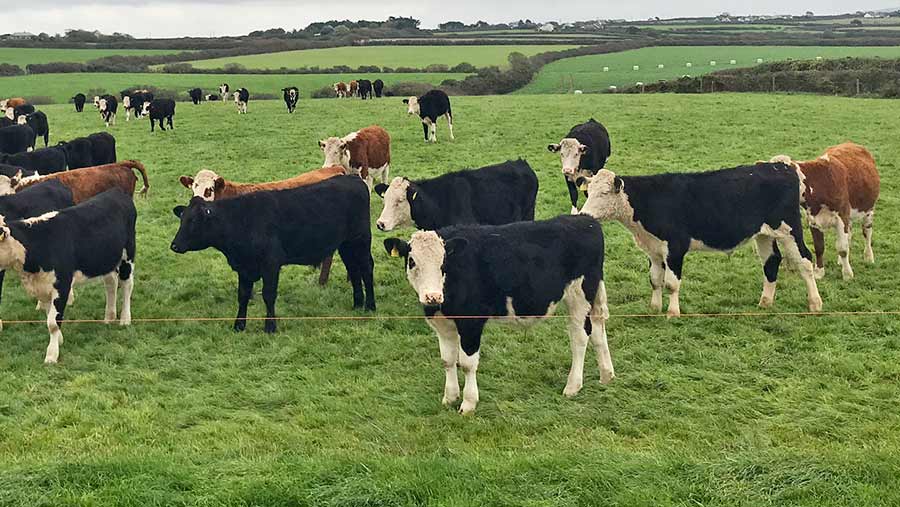How beef finishers have improved health and cattle weight gain
Productivity and efficiency are core principles of running a profitable beef enterprise, but with so many influential factors it can be a challenge to know what to target.
Mixed beef and sheep farmers Mike and Clare Parnell and nephew Philip Kent have been working as an AHDB Beef & Lamb strategic finisher farm to boost the efficiency of their beef finishing enterprise by focusing on three main areas: calf management, housing and feeding.
Improvements have included better biosecurity and ventilation, a shift to rotational grazing, and accurate weighing of stock.
See also: Award-winning beef farmer sells suckler herd in switch to dairy
They buy in batches of 140 cattle as calves every January, June and September to finish at between 16 and 22 months, at Treswarrow Park Farm, near Port Isaac, Cornwall.
Together with Debbie Brown, AHDB strategic farm consultant, they explain what improvements they have made and what benefits they have had.

Philip Kent
Farm facts
Treswarrow Park Farm, Port Isaac, Cornwall
- Farmed in partnership between Philip Kent, Clare Parnell and Mike Parnell
- 172ha over six blocks of land
- 1,110 ewes and 320 beef cattle
- Calves bought at two to three weeks of age
- Mixed breeds including Fresian steers, Belgium Blues and Natives which run on a grass-only system
- Cattle sold deadweight as 16-22 months at 270-400kg
Calf management
Objective Improving youngstock management in the first 12 weeks.
Changes
- Changed the milk powder to a more starch-based formula with high-quality bypass protein to try and get a good frame and efficient growth from a very early stage.
- Included chopped wheat straw in the diet to promote gut health and drive rumen development from an early age. Straw is fed in buckets to help increase intakes.
- Mucking out frequency increased to every three weeks.
- Improved water cleanliness by cleaning troughs more regularly.
- As the farm buys in its calves, they also put extra focus on weighing the animals as they come in and throughout the rearing process. Previously, they estimated the weight of calves as they came off the trailer and always presumed there was a 5-10kg weight range. However, the last two batches have been weighed properly. In the last lot of British Blues there was 35kg weight range, so knowing this helped monitor growth rates more accurately.
Benefits
- Better appearance of calves coming through, particularly added shine to their coats and a solid frame.
- The increased feed intake as a result of the chopped straw has led to improved growth rates. Growth rates in calves have increased by an average of 100g/day, taking overall daily liveweight gain from 950g to 1.1kg/day.
Housing developments

Objective An independent person was brought in to review housing and suggest improvements.
Fortunately, the farm had recently erected a purpose-built calf shed designed for pens of up to 10 calves, with a tube ventilation system running throughout to increase airflow and lower the risk of calf pneumonia. As this had been specifically designed with calf health and comfort in mind there weren’t too many issues highlighted in the review.
Changes
- The only recommendation was to pipe washing water away to minimise contamination and reduce humidity – something which they have now done.
- In the old pens, which were spread across the farm, the calves had to be moved as soon as they were weaned as the pens weren’t big enough. At this point they noticed they started getting health issues due to the stress of movement.
- For older cattle, the review flagged up the need for better ventilation in two other sheds. To rectify this, they remove side boards as and when needed.
Benefits
- As a result of minimised movement by increasing pen size and having a purpose-built area for calves, by the time they leave the shed calves have settled into a weaned calf diet and are far less stressed.
- Reducing stress in youngstock has consequently improved the health of the animals meaning there has been a reduced need for antibiotics.
- Similarly, increased airflow in the main cattle shed has improved both herd health and cow comfort.
Improvements to grass use and feeding

Objective They wanted to get more out of the grass, so they implemented a nutrient management plan to ensure they were producing the best-quality forage possible.
Changes
- Soil sampling revealed while the pH was good, there was a need to review P and N applications. They had been using an NPK compound, but they are going to increase the rate of phosphate as they only applied this at maintenance rates previously. Low phosphate had been a long-standing issue within the farm’s soils, so now they are using a specifically designed nutrient plan to gradually bring the levels back up.
- The farm was doing a small amount of rotational grazing before, but over the past 12 months has rolled it out, which has proven incredibly beneficial with the challenging season this year. Rather than rotationally grazing fields they have split fields into paddocks using electric fencing to improve grass use.
- They also started using a plate meter to assess and manage the grass availability.
Benefits
- As a result of the changes the farm has grown a lot more grass. This year the farm made an additional 270 silage bales – despite the drought – which helped see them through the summer. Mr Kent comments: “Those rotations early on in the spring and the extra grass growth really helped to get us through that hungry period.”
- Better grass use has also eased reliance on concentrates. “Normally, our Blue yearlings would have supplementary feeding twice a day at grass. This year we have dropped them back – reducing feeding by 1.5kg per head – and had them grazing rotationally with cattle roll on the floor,” he adds.
- Weights are 20kg off where they should be this year due to the drought over the summer, but they have got more frame. However, with the compensatory growth that’s expected while they’re housed for finishing in November I am not too worried about this.”
Target/improvements |
||
| As part of the AHDB Strategic programme the farm has set four key performance targets which it aims to meet over the next 12 months | ||
|
Performance targets |
Current level |
Target |
|
Improve daily liveweight gain in the finishing period |
1.1kg/day |
Achieve >1.3kg/day in the 2017-born animals that will finish in 2018 |
|
Increase steers classified at fat class 3 |
49% |
60% of steers classified at fat class 3 in 2018 |
|
Increase cattle graded at R or better |
78% |
85% of cattle slaughtered in 2018 should grade at R or better |
|
Reduce liver condemnations from liver fluke |
7% |
2% livers condemned due to liver fluke in 2018 |
